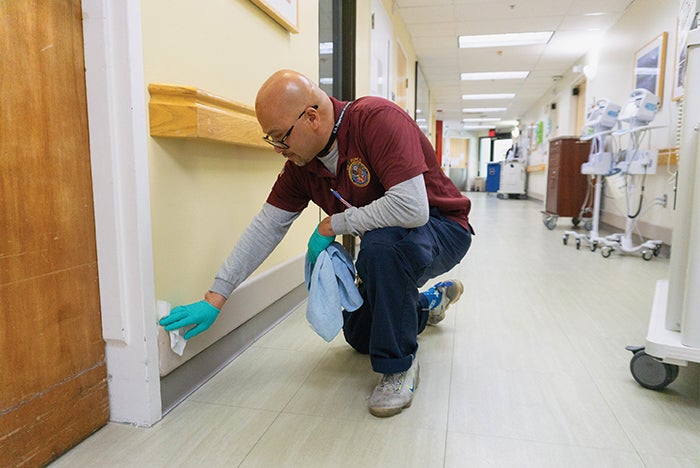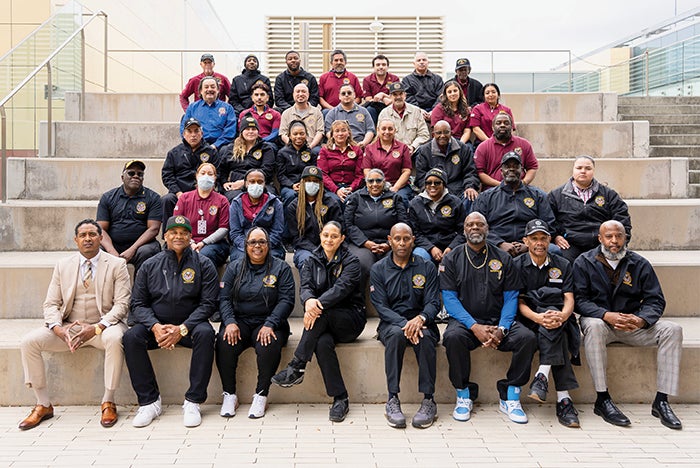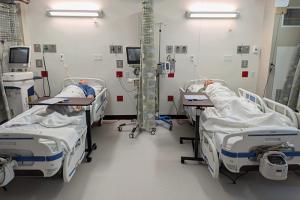2025 EVS Department of the Year: VA Palo Alto Environmental Management Service

VA Palo Alto Health Care System Environmental Management Services’ Jeffrey E. Miller (center) displays the EVS Department of the Year Award while flanked by two assistant chiefs on the hospital grounds.
Image courtesy of VA Palo Alto Health Care System
They say there’s strength in numbers, and that’s certainly true at the Department of Veterans Affairs’ VA Palo Alto (Calif.) Health Care System (VAPAHCS), where its Environmental Management Service (EMS) department has turned focused goals and smart data tracking into measurable success.
This industrious approach has led to notable progress in sanitation quality, bed turnaround times, operating room readiness and the use of ultraviolet-C (UVC) disinfection systems. The department also has strengthened its aseptic inspection program using adenosine triphosphate (ATP) testing, enhanced aesthetic inspections through visual evaluations, improved waste and recycling systems, and reinforced pest control measures.
Additionally, a comprehensive new employee orientation and in-house training program now supports both new and existing staff. Impressively, 45% of the EMS team holds Certified Healthcare Environmental Services (EVS) Technician credentials. Professional floor care specialists and trained flood response teams are stationed across three main campuses in Palo Alto, Menlo Park and Livermore. Communication boards, quarterly newsletters and engagement activities help maintain strong team cohesion and retention.
Many of these improvements can be credited to effective querying. EMS actively gathers patient feedback using the VA’s Survey of Healthcare Experience of Patients (SHEP), outpatient polls, non-VA surveys and two in-house surveys. Insights from these polls also guide improvements in housekeeping and linen services, ensuring patient expectations for a clean and safe environment are met — and often exceeded.
Watch VA Palo Alto Health Care System's story
“Our efforts have yielded remarkable results from independent internal and external evaluations,” says Jeffrey E. Miller, EMS housekeeping officer for VAPAHCS. “During annual inspections by entities such as Joint Commission and the VA Office of Inspector General, there were no findings of EMS deficiencies. What’s more, our SHEP scores consistently surpass Veterans Integrated Service Network (VISN 21) and national averages, with VA Palo Alto ranked second in hospital cleanliness among the highest complexity facilities nationwide for fiscal year 2024. Also, a non-VA survey ranks VA Palo Alto among the top hospitals in the area.”
Data-driven improvements
EMS evaluates its operations through multiple layers of review, including daily shift huddles, weekly task completion checks, biweekly contract assessments, and monthly contractor performance and budget reviews. Progress is monitored monthly through what Miller calls a “bowling chart” that tracks key performance indicators, such as bed turnaround time, ATP aseptic and visual aesthetic inspection scores, UVC disinfection performance, concentrated disinfectant dispenser testing, training completion rates and SHEP satisfaction scores. Results from aseptic and aesthetic inspections are then compared with health care-associated infection data provided by the infection prevention and control department.

An EVS supervisor and technician collaborate on floor maintenance.
Image courtesy of VA Palo Alto Health Care System
One of EMS’s most impactful projects has been the development of customized UVC disinfection setups for different patient care areas. The department’s quality assurance (QA) group used dosimeter cards to confirm effective dosage levels capable of eliminating 99.9% of C. diff bacterium. This has led to location-specific protocols for room preparation, emitter placement, mode and duration. Reference cards are now being developed for UVC operators at all three VAPAHCS campuses, and the program has been shared with other VA facilities.
“To standardize the inspection flow, provide tracking visibility, follow up on discrepancies, and assist with data analysis and report generation, our QA group also developed an error-resistant inspection process using a supervisor group software rounding tool,” Miller says. “By working closely with EMS supervisors and site managers to understand and meet their requirements, the tool has been effectively integrated and is now part of our training officer’s annual training competency program.”

An EVS technician cleans overhead lights in the operating room suite.
Image courtesy of VA Palo Alto Health Care System
EMS has further embraced innovation by launching a restroom feedback system accessible via QR code and creating in-house digital tools for sanitation, linen and waste inspections. A centralized portal now manages service requests for cleaning, linen, supplies, waste and pest control. Databases track equipment, textile/linen inventory and ATP luminometer calibration schedules. Additionally, the bed management system has significantly improved bed acceptance and close-out processes. These various technology integrations have paid off, boosting achievement rates from 80% to 95%.
Kudos and lessons learned
VAPAHCS consistently earns kudos for its high-quality cleaning operations. That’s little surprise, considering that Miller’s department continues to conduct ongoing training on sanitation techniques, ensures proper use of VA-approved cleaning agents and routinely performs UVC disinfection in patient discharge rooms and critical areas. Frequent visual inspections, ATP audits and rapid responses to cleaning requests remain key priorities for leadership.

An EVS technician maintains the hospital’s baseboards.
Image courtesy of VA Palo Alto Health Care System
“To reduce waste, we enhanced the equipment maintenance program by implementing scheduled calibrations, maintenance tracking and usage training to extend the life expectancy of equipment,” Miller explains. “In addition, our recycling program includes shredder bins for document destruction and containers for cardboard recycling. Food compost collection was established for our nutrition and food service and canteen service areas as well. In 2024, EMS also set up a three-compartment recycling program across all campuses to collect compost and mixed recycling of glass, aluminum, and plastic bottles and cans.”
Other health care organizations can draw inspiration from EMS’s integrated approach, which calls for maintaining leadership visibility, fostering innovation, implementing thorough inspection programs with strong data tracking and investing in comprehensive training.

First and second shift environmental services assistant chiefs, supervisors, leads and technicians commemorate the news that the hospital’s Environmental Management Service won the Association for the Health Care Environment’s EVS Department of the Year Award in the 500-plus beds category.
Image courtesy of VA Palo Alto Health Care System
Miller and his team also have demonstrated that creating a robust QA group — one that maintains a central role in auditing quality, managing budgets and driving Lean process improvements — can make a big difference. Collectively, forward-thinking strategies like these can help create a consistently clean, safe and patient-focused environment.
“Being recognized by the Association for the Health Care Environment with an EVS Department of the Year Award is gratifying and rewarding because it highlights the dedication, hard work and innovative solutions our team has put into ensuring a safe and clean environment for patients and staff,” says Miller. “This recognition not only honors our commitment to excellence in EVS but also motivates us to continue striving for the highest standards in health care facility maintenance and patient care.”
Kimberly Miller, BS, CMIP, T-CHEST, T-CNACC, T-CSCT, vice president of support services for Valley Medical Center in Renton, Wash., and one of the review committee judges, commends VAPAHCS for providing the most supporting data among all the award candidates.
Learn more about the Environmental Services Department of the Year Award
Erik J. Martin is a freelance writer based in Oak Lawn, Ill.




